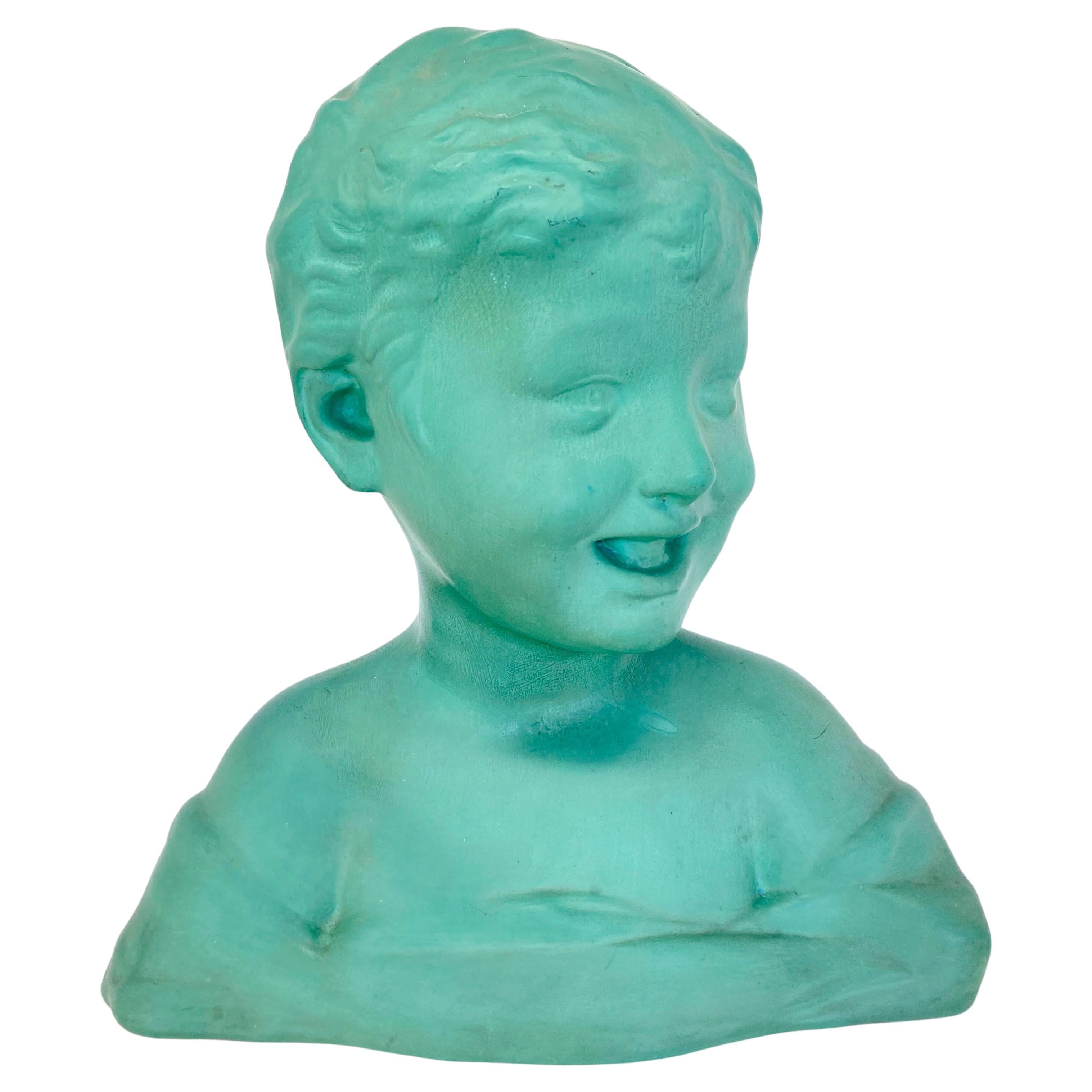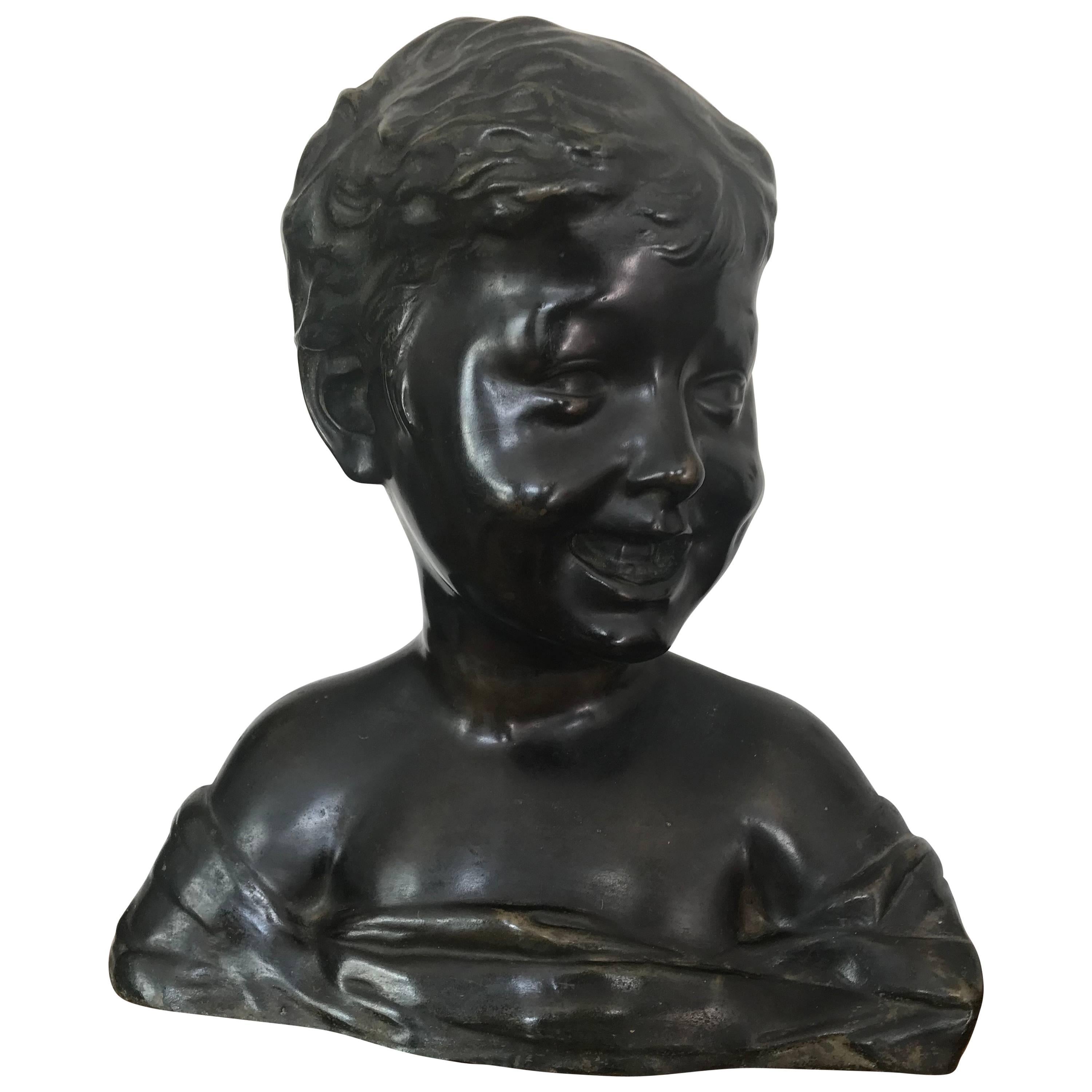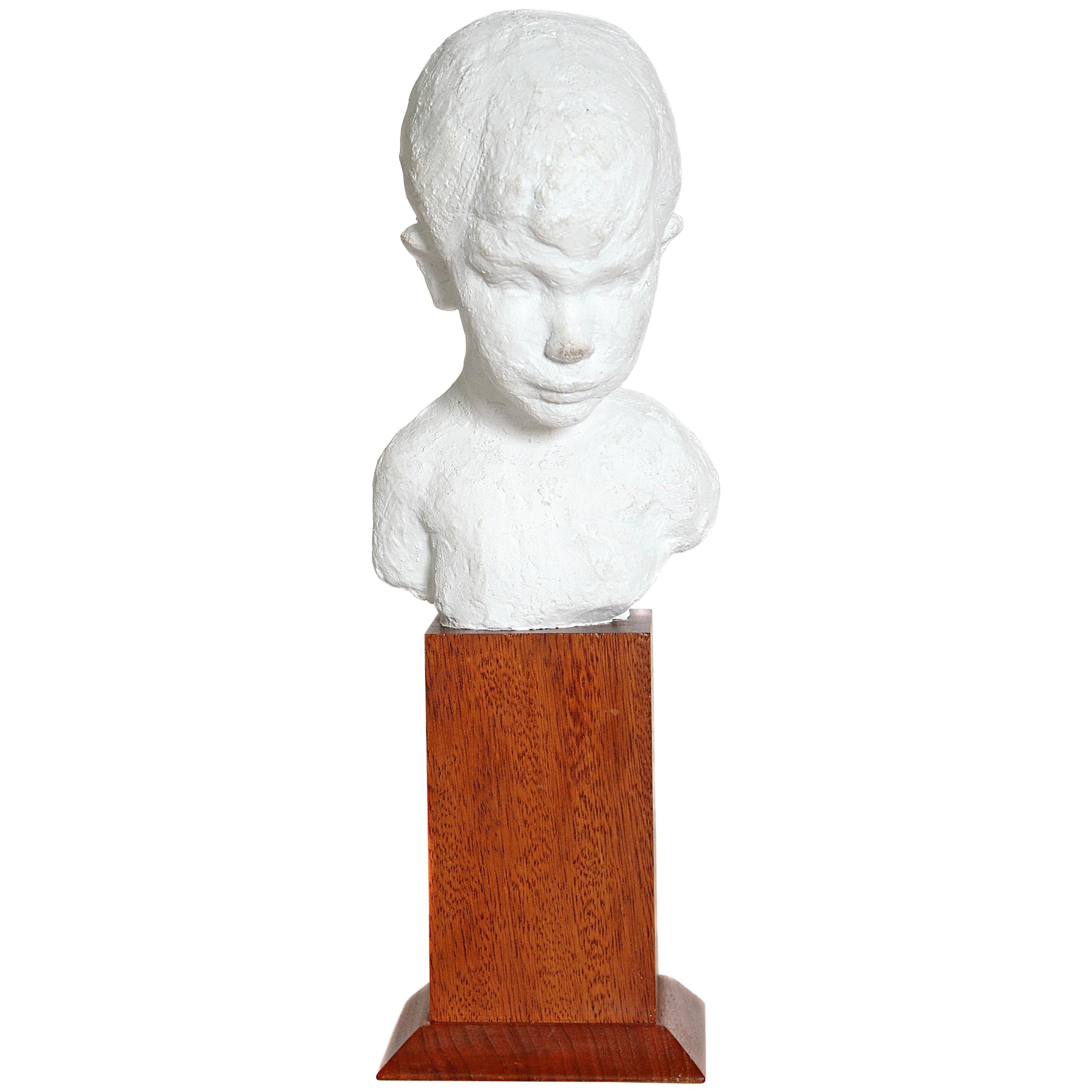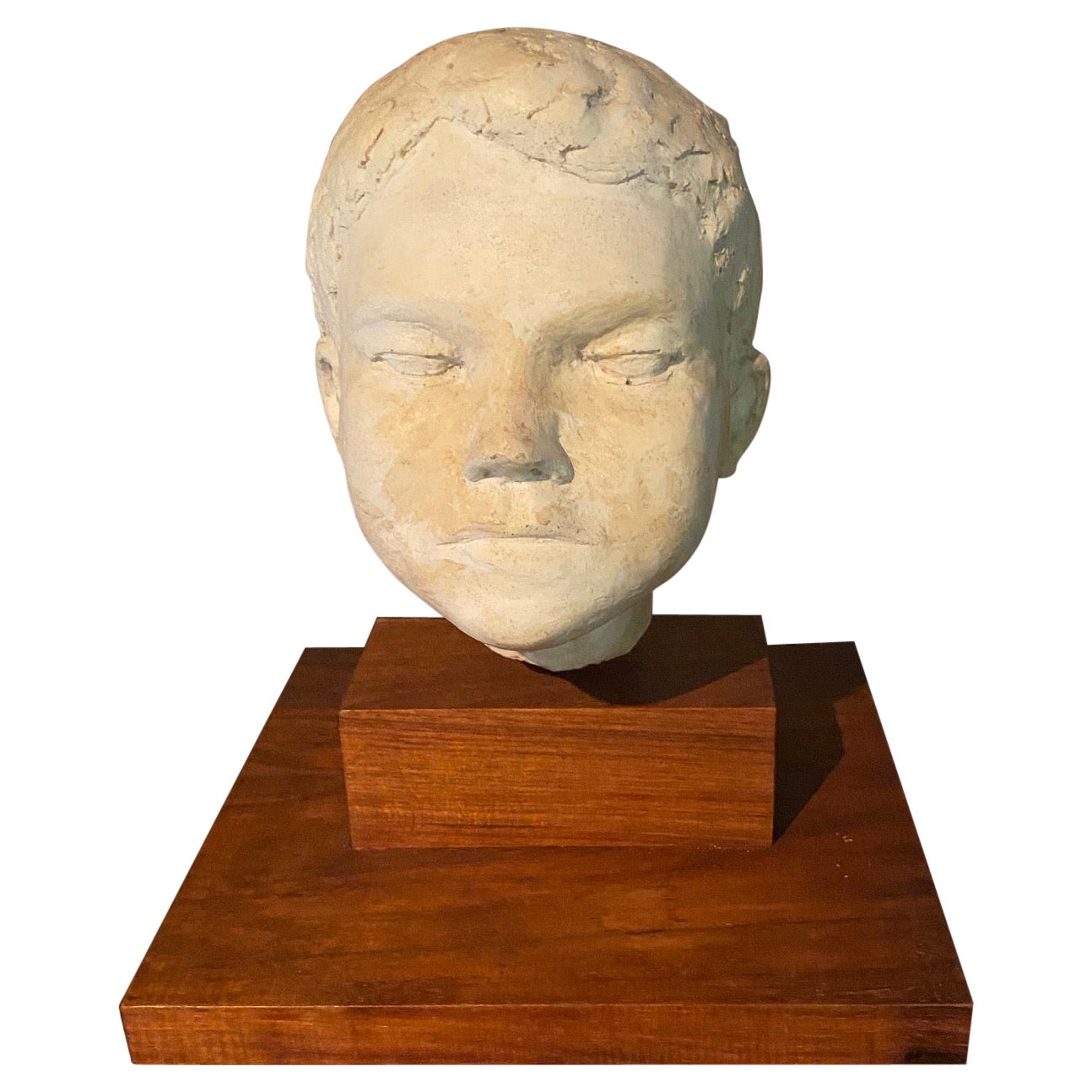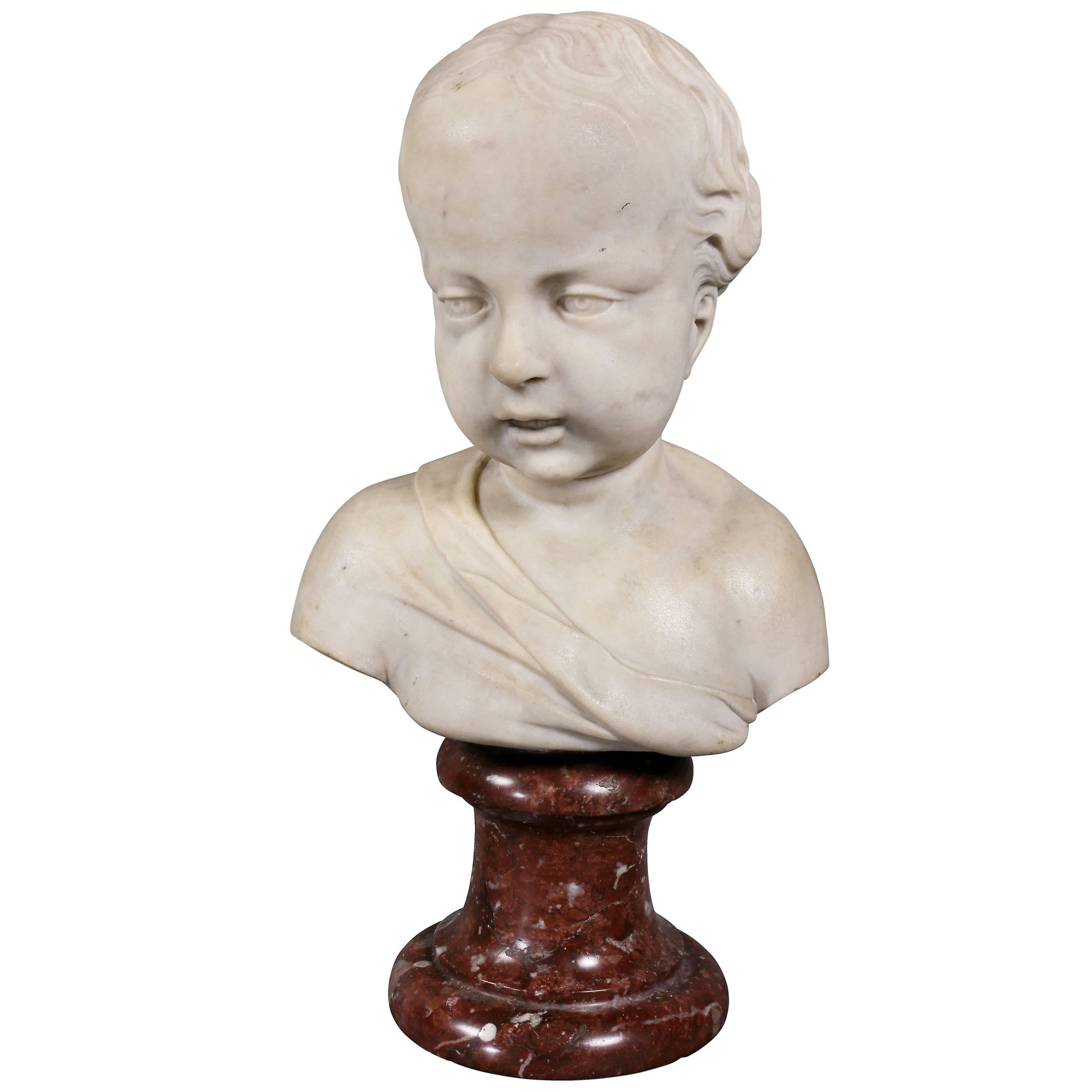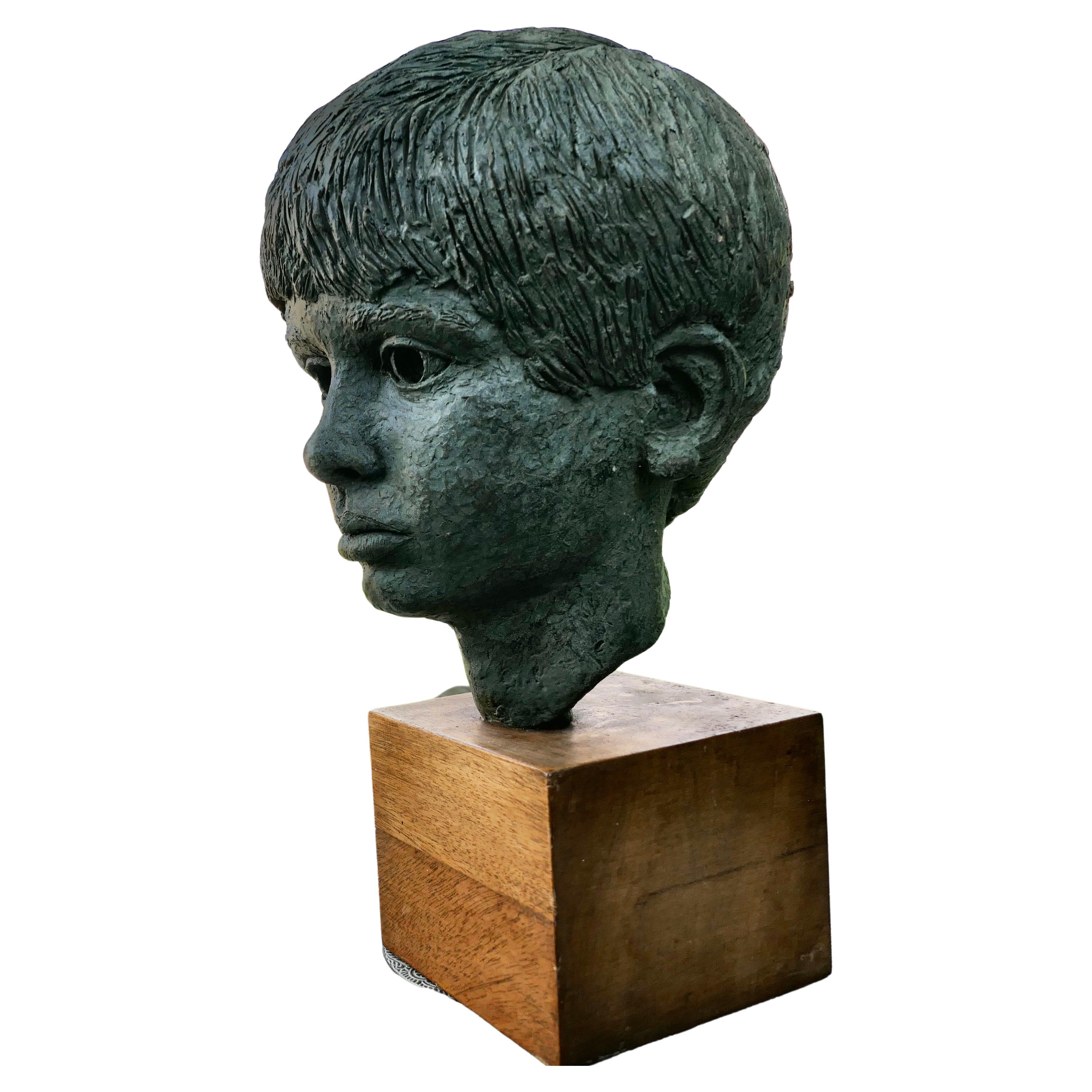Items Similar to Antonio Rossellino (Settignano 1427 - Firenze 1479) - Bust of a young boy
Want more images or videos?
Request additional images or videos from the seller
1 of 6
Antonio Rossellino (Settignano 1427 - Firenze 1479) - Bust of a young boy
About the Item
Attributed to Antonio Rossellino (settignano, 1427 - Firenze, 1479)
Bust of a young boy
1470-1475
Polychrome stucco
35 x 31 x 15,5 cm
- Published on the exhibition catalogue :
A. Del Priori, in Rinascimento Segreto, a cura di Vittorio Sgarbi, 2015, pp. 170-171
The small sculpture represents the bust of a young boy dressed in a white shirt, with the collar visible, and a red jacket open in a V shape on the chest. Cut just under the shoulders, the sculpture represent a little boy of a very young age, probably around three years-old. The face is characterized by a slightly upturned nose, rosy and chubby cheeks, and a small and expressionless mouth. The bust rests on a hexagonal contemporary base partially gilded.
It is a charming polychrome stucco that a restoration (2014) has freed from overpainting and dirt, revealing its considerable quality. The plastic carving of the eyes, drawn as if with a scalpel, and the broader eyebrow arch, as if modeled with fingers, suggest an artist of exceptional technique. The stucco is skillfully carved as to evoke the smooth skin of the cheeks and the chubby flesh of the neck.
Such command of contours, subtle gradations of surface textures and sensitivity of expression are characteristic of the style of sculptor Desiderio da Settignano, who brought an unsurpassed level of observation to the portrayal of children. The theme of young children allows Desiderio to play on a wide range of emotions. It is probably no coincidence that this theme is one of the most frequently explored by the artist in various genres: within groups of Virgins and the Child, in busts of
independent children, perhaps secular or more likely religious, such as the Child Jesus or Saint John the Baptist, in angels bearing coats of arms or angels bearing candelabras around funerary or sacred monuments.
The busts of a young boy in Washington embody this ability to capture the transient nature of a smile in the process of forming. This art of nuance is complemented by an ability to capture the softness of the modeling of the lips, dimples, and curves of a still tender face. These sentiments are found in the terracotta bust at the Jacquemart-André Museum.
The Getty Young Boy present some similarities with our sculpture. However, the difference in the carving of the hairstyle, with elegantly intertwined locks which strongly reflects the grace of Desiderio da Settignano, and which in this stucco is simply painted in brown on the surface, leads to the conclusion that it is not by the hand of Nativo di Settignano.
The pronounced Tuscan features of this bust, coupled with stylistic similarities to certain Renaissance busts of young boys by Desiderio da Settignano, have led to the attribution to Antonio Rossellino. The sculpture was featured in an exhibition curated by Vittorio Sgarbi in 2015 and was subsequently published in the exhibition catalogue.
Close comparisons can be made with some of Antonio Rossellino's Children, such as the stunning one in the terracotta Madonna at the Victoria and Albert Museum (which also has a controversial attribution often shared with his brother Bernardo) or the one in the round with the Madonna of the monument to the Portuguese cardinal in San Miniato al Monte in Florence. However, the most effective parallel seems to be with the small and extraordinary bust of young Christ preserved in Palazzo Davanzati in Florence. The Florentine theologian, Cardinal Giovanni Dominici, recommended around 1410 that parents display images of the Christ Child and the young John together in their homes, as religious and moral examples for their children. When it was first made, this bust may have served just such a purpose in a Florentine home. Like Desiderio, Antonio Rossellino probably came from Settignano. He was the most accomplished sculptor among five brothers, all trained in the important workshop led by the eldest brother Bernardo. Widespread admiration for Antonio's skill may explain why his nickname Rossellino, "little redhead," came to be attached to all his brothers, replacing the family name Gambarelli.
The bust of a young boy was a Renaissance sculptural genre, most likely invented by Desiderio, that originated in mid-quattrocento Florence and whose production ended around 1510, with the fall of the republic. Executed in marble, terra-cotta, or stucco, similar busts were produced in sizable numbers in the workshops of artists such as the Rossellino brothers, Bernardo and his younger brother Antonio, as well as Desiderio da Settignano. There are no comparable painted counterparts, and the genre has a production span of only about fifty years. These devotional images were used both in private settings, for domestic devotion, and as decorative elements in religious buildings.
These portrait busts are unique to the Renaissance. Antique busts of children do exist but are of a nature contrary to those created in Quattrocento Florence. Roman busts of children normally exhibit none of the liveliness that makes the Renaissance examples so distinctive and charming. The ancient busts are usually filled with sober dignity, without the spontaneity and vivaciousness of childhood itself. Indeed the most common sculptural representations of children in classical art appear either in funerary contexts or as part of the cult of ancestor worship, which partly explains their sobriety.
In Renaissance sculpture, children were often portrayed as symbols of purity, vulnerability, and divine grace. Artists drew inspiration from classical ideals while infusing Christian values into their creations. The innocence associated with childhood became a powerful metaphor, representing the human soul's journey towards spiritual enlightenment.
Such busts belong to a 15th-century context in which childhood was first recognized as a distinct stage of life and their purpose may have been to lay the foundation of nobility, in a civic consciousness of patrons who saw children as the future leadership of the republic. They reflect awareness of ancient Roman portrait-busts but are infused with a liveliness alien to their Roman forerunners. Children had a new status as individuals during the Renaissance, and their moral development was of increased concern, not only to parents but also to the state, which needed them as good citizens.
Moral and religious education, considered essential to the proper Christian rearing of children, was of paramount importance and employed several mimetic devices. Theologians suggested that images of saintly figures were good models for boys and girls, particularly if they were depicted at similarly young ages, and recommended that such images be displayed at home (see “Advice for the use of religious images in childrearing”).
Three-dimensional depictions of holy figures were regarded as possessing their own spiritual and virtuous essence, which could be transferred to worshippers engaging with them. Thus, young women often kept in their bedrooms private portable images known as “holy dolls,” contemplation of which it was believed would help to inspire virtuous behavior in their unborn children. For the same reason, busts of the young Christ, sometimes paired with busts of the infant Baptist, were frequently found in Florentine homes. Through the mother's spiritual contemplation of the doll and the doll's physical presence near the child, it was presumed that the effigy could inspire virtuous behavior in the unborn child. In a complementary manner, the portrait busts of children in Quattrocento Florence reflect a related belief in the ability of images to affect the beholder.
Preachers such as the Blessed Giovanni Dominici urged parents to keep painted and sculpted images of holy figures in their homes, as examples for their children: “To have paintings in your house of child saints or young virgins, in which your own child, whilst still in its swaddling clothes, will be delighted by the example set him and will act according to the exemplar, with acts and signs appropriate to childhood. And just as I speak of paintings, the same I would say for sculptures.”
The appearance of these busts in the Quattrocento derives from an increased sensitivity toward the child, and in particular the male child. Contemporary sources indicate that the male child was seen specifically as the embodiment of the future of both family and state. Producing children to perpetuate the Florentine republic thus satisfied a civic obligation. Such sentiments are not new; indeed they can be traced back to ancient Rome. Yet their unique articulation in civic humanist philosophy-and artistic creation -became one of the hallmarks of Renaissance Florence. Portrait busts of children thus emerged in a cultural context of increasing civic and personal sensitivity toward the nature of the child as a sentient and consequential being. Children represented the promise and continuity of both the Republic and its families. The public expression of this new perception of children, is seen in the foundation of the Ospedale degli Innocenti, prompted by concerns for the welfare of children as a responsibility of the state. It's façade by Brunelleschi display one of the most verist images of infants during the period. Children in fact became the physical guarantors of lineal succession and civic prosperity. The child literally embodied the future and the character of that future would essentially be determined by the child’s development. These new depictions of children represented much more than just actual or sacred childhood. They were both real and ideal images of the future family and state. Only partially intended for the child, they also served the parent by giving visual promise of virtuous offspring and assuring the continuity of lineage through a worthy male line. But the busts are never exact likenesses of any actual child. They were based on natural form and expression, yet all are idealized images. No child bears a physical flaw or displays a blemish. None looks anything other than the personification of young innocence. They look similar because what they represent are ideals rather than appearances. This idealizing tendency is also manifested in the convention of giving the busts of boys indeterminate ages. The presumed ages vary from infancy to adolescence but are intentionally vague, since the busts are embodiment of youth and not depictions of a single specific child at a certain time. These busts proved a short-lived phenomenon. In fact, they virtually disappeared with the fall of Florentine republic.
The use of stucco perfectly illustrates the "carefree and imaginative" work of sculpture workshops in Florence during the Quattrocento. These workshops had to be imaginative to meet the high demand for devotional images. Not only did they respond to this demand, but they also stimulated it by offering variety. The choice of stucco, more commonly used than terracotta and cartapesta for reliefs from the production of Antonio Rossellino, is justified for several reasons. Inexpensive, lightweight, and durable, stucco was suitable for works sometimes exported over long distances.The general availability of works in plaster, however, did not mean that they were the preserve of the less wealthy, and reliefs of the Virgin and Child in plaster, as well as casts after local relief sculpture, are listed in the household inventories of the elite, including the Medici.
Stucco was the focus of particularly wide-ranging experimentation in the Quattrocento, and especially in the Florence of Donatello, where artists and architects deployed this versatile material to create figural and relief sculpture and novel decorations that blurred traditional distinctions among mural decoration, sculpture, and architectural ornament.
In Renaissance Italy, some sculptural works in plaster were produced by a mechanical casting process involving moulds that themselves were often made of plaster; others, like this bust, were modeled by hand. Once fully set, such objects could be manipulated further with saws, rasps or files (some traces are still visibles in this bust). As regards surface treatment and outward appearance, probably only very few were left untreated or simply varnished so as to provide them with a protective outer skin. Rather, away from artists’ workshops, the majority of these works appear to have been patinated to look like bronzes, were gilded with gold leaf, or painted to look life-like as the one we present. As a result, they did not betray their materiality to the beholder and would therefore have been difficult to distinguish from works in the sculptural materials they imitated through patination, or from other polychrome works, in wood, terracotta or papier mâché. It was the availability, cheapness and versatility of plaster as a material that allowed it to play an important role in making accessible sculptural products for those more modest, though by no means poor, parts of the Florentine society, for whom sculpture in marble or bronze was out of reach.
The representation of children in Renaissance sculpture transcended mere portraiture; it became a profound exploration of innocence, spirituality, and the beauty inherent in the fleeting moments of childhood. Through the hands of master sculptors, these depictions contributed to the rich tapestry of Renaissance art, offering viewers a glimpse into the timeless and universal aspects of human experience.
The busts were artistic expressions of a civic humanism based on democratic ideals of the future of the state and its citizens. Once the future was fated to be autocratic rather than democratic, these manifestations of republican civic promise ceased to have much relevance, and the genre came to an end.
This bust is, therefore, a rare and interesting example of a sculptural genre that reflects the specific political situation in Florence, vividly illustrating its civic ideals. The brief lifespan of such works makes this sculpture a rare testament to a particular historical, philosophical, political, and artistic moment that allowed the extraordinary flourishing of the Renaissance.
- Dimensions:Height: 13.78 in (35 cm)Width: 16.15 in (41 cm)Depth: 6.11 in (15.5 cm)
- Style:Renaissance (Of the Period)
- Materials and Techniques:Stucco,Polychromed
- Place of Origin:
- Period:
- Date of Manufacture:1470-75
- Condition:Wear consistent with age and use.
- Seller Location:Bruxelles, BE
- Reference Number:1stDibs: LU6666239673922
About the Seller
5.0
Vetted Seller
These experienced sellers undergo a comprehensive evaluation by our team of in-house experts.
1stDibs seller since 2022
6 sales on 1stDibs
Typical response time: <1 hour
- ShippingRetrieving quote...Ships From: Bruxelles, Belgium
- Return PolicyA return for this item may be initiated within 3 days of delivery.
More From This SellerView All
- Agnolo di Polo Firenze 1470 - Arezzo 1528' - Saint Nicholas of TolentinoLocated in Bruxelles, BEAgnolo di Polo (Firenze 1470 - Arezzo 1528) Saint Nicholas of Tolentino Around 1510-1520 Painted and gilded terracotta 55.5 x 24 x 16.5 cm San Nicholas de Tolentino is represe...Category
Antique 16th Century Italian Renaissance Figurative Sculptures
MaterialsTerracotta
- Terracotta Bust of Christ as the Redeemer, 15th CenturyLocated in Bruxelles, BEA terracotta bust of Christ as The Redeemer Tuscany or Emilia Romagna, late 15th century Measures: 46 x 43 x 21 cm This powerful, moving bust of...Category
Antique 15th Century and Earlier Italian Renaissance Figurative Sculptures
MaterialsTerracotta
- Group of Altarpiece - Antwerpen, 16th centuryLocated in Bruxelles, BEGroup of altarpiece representing the life of a Saint, Saint Renualde? Engraved by the sign of Antwerp hand on the hat of the central character Carved oak, traces of polychromy Fir...Category
Antique 16th Century Belgian Renaissance Figurative Sculptures
MaterialsOak
- Cercle of Romano Alberti, Page, Around 1530-1540Located in Bruxelles, BECercle of Romano Alberti, dit Il Nero da Sansepolcro ( San Sepolcro, 1521-1568 ) Page Mixed media : wood core, papier mâché, stucco, polychrome and gilded Italy, around 1530-154...Category
Antique 16th Century Italian Renaissance Figurative Sculptures
MaterialsStucco, Wood, Paper
- Hercules Holding a Coat of Arms, Flemish, XVII CenturyLocated in Bruxelles, BEHercules holding a coat of arms Flemish, XVII century White and black marble Measures: 67 x 32 x 19 cm Hercules is depicted naked, holding a coat of arms with the right hand an...Category
Antique 17th Century Belgian Renaissance Figurative Sculptures
MaterialsMarble, Belgian Black Marble
- Adoration of the Magi, Flanders, 17th CenturyLocated in Bruxelles, BEThe Adoration of the Magi. Panel carved in high relief. Flanders, 17th century. Measures: 53 x 32,5 cm.Category
Antique 17th Century Dutch Renaissance Figurative Sculptures
MaterialsWood
You May Also Like
- 1920s French Terracotta Bust by Saint-Clément Copy of Settignanos Laughing BoyBy Saint-ClémentLocated in COLMAR, FRA lovely terracotta bust of a child made by the famous french pottery producer, Saint-Clément. Undated but most likely from the 1920/30s, the bust was part of the "Terre Cuite d'Art"...Category
Vintage 1920s French Medieval Busts
MaterialsTerracotta
- Antique Bronze Sculpture or Bust of a Laughing Boy aft. Desiderio Da SettignanoBy J. PetermannLocated in Lisse, NLRare bronze sculpture of a joyous boy from the early 1900s. The sculptor of this Fine work of art has managed to capture the pure innocence and joy of a young child. Kunsthistorisches Museum Vienna on Laughing Boy — The representation of children belongs among the most charming motifs revived by Renaissance art under the influence of Hellenism. Like a number of similar statuettes of equally unaffected charm, this one is probably the portrait of a child conceived as the infant Jesus. Such statuettes were commissioned to be set up in private chapels. The Laughing Boy is considered to be the last work of Desiderio da Settignano...Category
Early 20th Century Belgian Religious Items
MaterialsBronze
- Bust of Young Boy on Mahogany StandLocated in Dallas, TXA very appealing naturalistically portrayed bust of a young boy. Terracotta with a plaster finish. Signed on back. Sets on a mahogany wood pedestal. Dimensions of bust only: 6.75...Category
Mid-20th Century American Modern Busts
MaterialsPlaster, Mahogany, Terracotta
- Plaster Sculpture Bust of Young BoyLocated in Montreal, QCPlaster sculpture bust of young boy the dimensions are with the base.Category
Antique Early 1900s French Busts
MaterialsPlaster
- Louis XVI Marble Bust of a Young BoyLocated in Essex, MANicely sculpted with most likely a later brown and white marble socle.Category
Antique Late 18th Century French Louis XVI Busts
MaterialsOther
- Artist’s Model Bust of a Young Boy, not signedLocated in Chillerton, Isle of WightArtist’s Model Bust of a Young Boy, not signed This is a very attractive hand made piece dating from the middle of the 20th Century, it was discover...Category
Vintage 1960s Folk Art Busts
MaterialsClay
Recently Viewed
View AllMore Ways To Browse
San Antonio Used Furniture
Used Furniture In San Antonio
A Younger Furniture
Antique Furniture San Antonio
San Antonio Antique Furniture
Bust General
Renaissance 15th
Saint Display
Dress Boy
Italian Cardinal
Antique Stucco
Stucco Antique
Fall Of Rome
Renaissance Nature
Renaissance Period Paintings
Fall Tapestry
Angel With Child
Boy Male
